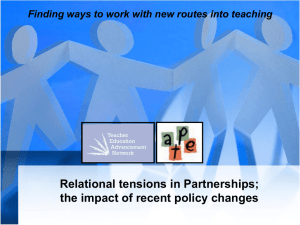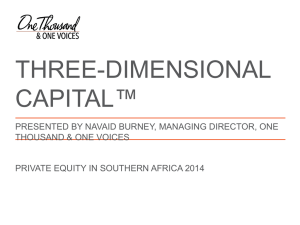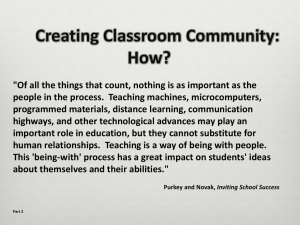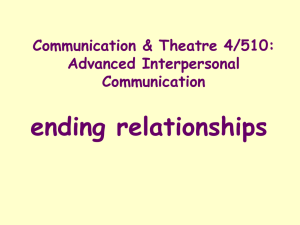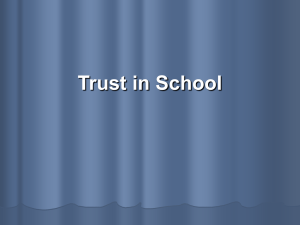Behavior
advertisement
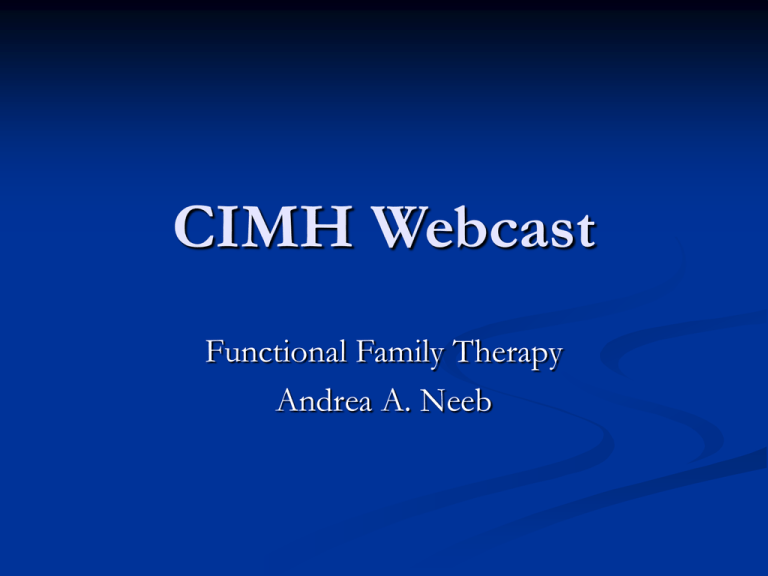
CIMH Webcast Functional Family Therapy Andrea A. Neeb ”What really is the difference between a Relabel and a Reframe anyways??” Let’ s talk Relational Functions Behavior Change planning and examples..”How do we address multiple risk factors and still stay within sessions timeframes??” Introduction to Meaning Change Techniques Engagement & Motivation Phase, FFT 1 – Relabel: Provides an alternative, more benign “label” for a specific behavior, emotion, attribution. 2 – Theme hint – short comment about a possible alternative domain (especially emotional / affective) involved in a negative behavior – one that tends to arouse less blaming and negativity. 3 – Reframe: introduces less intense and possibly more benign motives or “reasons” for the negative Behavior. 4 – Reframe +: suggests noble but misguided intent with respect to a family member’s negative behavior. 5 – Behavioral Theme: identifies a specific sequence, usually of within-family behaviors, with reframes and/or relabels of most or all of the specific behavioral elements, in a way that suggests non-malevolent (and even possibly “noble”) intent or “reasons” behind all family members’ behaviors. 6 – Relational Theme: creates/suggests possible misguided benign, even noble, and sometimes “accidental” intentions behind longer term relational patterns and/or interpersonal styles. Relational themes often are quite nonspecific with respect to recent behaviors. Often they capture years of relational unhappiness, dysfunction, & negative attributions about self (e.g., as in depression) and others, with recent events being a window into them. 1 – Relabel: Provides an alternative, more benign “label” for a specific behavior, emotion, attribution. Mom: “I’ve had it with him … maybe he should go to “DT” (detention) for a while.” Therapist: - To youth: “Sounds like your Mom feels she has run out of steam to deal with this.” This relabel of Mom’s “feeling” (“I’ve had it with him”) as representing “running out of steam” tends to come across as less blaming and rejecting, and moves the focus off of a consequence (DT) that we as FFT therapists do not want to be our main focus or goal. In doing so it allows the therapist to refocus on family relational processes. 2 – Theme Hint – short comment about a possible alternative domain (especially emotional / affective) involved in a negative behavior – one that tends to arouse less blaming and negativity. E.g., In response to rapidly escalating parent-child outbursts: “OK … please forgive me for jumping here and interrupting, but there seems to be lots of feelings of loss going on in this family.” Note that this represents a “theme hint” because it is not “developed” at all – it is merely an assertion which the therapist is focusing NOT on the obvious anger, but is assertively jumping in to impact (actually stop if possible) the outbursts, but s/he does so in a way that: 1 – doesn’t take sides 2 – doesn’t tell them overtly that their behavior is “wrong” or a “problem to be fixed,” 3 – (hopefully) will change the focus away from the “content” of the anger and instead move them to other thoughts, feelings, memories, etc. .. 4 – by “hinting” about a possible “cause” (i.e., loss) for all the anger … even if the therapist isn’t aware (as we often aren’t in early sessions) of any specific content / history involving “loss.” Reframe: introduces less intense and possibly more benign motives or “reasons” for the negative Behavior. Reframe +: suggests noble but misguided intent with respect to a family member’s negative behavior. Reframes consist of three simple components: 1) Identify and make clear the negative aspects of a problem behavior / pattern (the one you are going to attempt to reframe); 2) offer a possible benign (Reframe) or perhaps even noble* (Reframe+) but misguided intent or meaning for the behavior; 3) based on the family members’ reactions (affirming or disaffirming) you refine and elaborate the reframe … or you apologize for “misunderstanding” and move on. * “Noble” intent = to benefit another Mother to Therapist: “This is the third time she has run away … she’s just out of control” Therapist: “And Mom … that is unbelievably disruptive to you and the whole family (clearly acknowledges the disruptive impact), and I’m sure someone along the line has suggested she is just trying to develop and show her independence (relabel) … but I’m wondering if there is something more. As misguided as it is, I wonder if she might also be trying to send you a message that ‘Mom, I see how burdened you are, so I’m trying to grow up fast so you don’t have to worry about parenting me as much.’ (the possible “noble intent” part of the reframe). Now we all know that this way of doing it won’t work, but I wonder if she has been able to tell you how worried she has been about your horrible stress level? It might even be easier for you both to argue about her (daughter’s) behavior than for either of you to feel the desperation that I’m sure sneaks up on you Mom. What is the Difference Between a Reframe and a Relabel? Relabel – to change the “tone,” description, or meaning of a behavior or feeling – but not necessarily address the motivation behind the negative behavior In response to an angry outburst: “With that anger I can see how agitated you are.” Note that “agitation,” when the word is introduced, seems less intense and perhaps even less “negative.” Both anger and agitation represent “feelings,” but “agitation” tends to take the focus off the negative behavioral aspect. Reframe – to acknowledge the negativity of a behavior but offer a possible alternative explanation or motivation for the behavior “That was a pretty angry outburst “X”, but I’m wondering if in addition to expressing your anger you weren’t also protecting “Y” (Reframe+) by letting her know how sensitive you are about that subject so she can work on bringing it up differently? And “Y,” my guess is that because his agitation (Relabel) was so intense you couldn’t hear the reaching out part of what “X” said. Themes (con’t) Like reframes, themes do include the elements of 1 – acknowledging painful and even “bad” patterns of behavior; 2 – suggesting possible “misguided but noble,” or at least benign (e.g., based on misunderstanding, etc), intentions ... or they may even be offered as possibly “unintentional.” 3 – being open to family member cues that indicate rejection, acceptance, or some other response (confusion), and capturing any movement towards less negativity and more hopeful reaction with therapist attention and elaboration. Major Types of Themes 5 – Behavioral (Sequence) Theme: identifies a specific sequence, usually of within-family behaviors, and provides reframes and/or relabels of most or all of the specific behavioral elements, doing so in a way that suggests nonmalevolent intent or “reasons” behind all family members’ behaviors. 6 – Relational Theme: creates/suggests possible misguided benign, even noble, and/or sometimes even “accidental” intentions behind longer term relational patterns and/or interpersonal styles. Relational themes often are quite nonspecific with respect to recent behaviors. Often they capture years of relational unhappiness, dysfunction, and negative attributions about self (e.g., as in depression) and others. Recent behaviors merely represent a “window” into these more basic (and usually sad!) relationship patterns. Transitioning From E&M to Behavior Change & Generalization Overarching Philosophy : Matching & Strength Based Relational Having Attained Balanced Alliance Decreased Negativity & blame Increased Family bonding Changed (Much more Positive) attributions Positive Body Language Hopeful Attitude Sense of “Familyness” And Accomplished R E L A T I O N A L A S S E S S M E N T Behavior Change Planning & Behavior Change Generalization, Multi-systemic Linking Within Family Relational Functions: “Attachment” When X relates to Y, the relational pattern (behavioral sequences in the relationship ) of X’s behavior is characterized by: high Autonomy: independence separating, Low levels of psychological intensity (Fear of Enmeshment?) 1 2 Autonomy Midpointing 3 4 Contact/ closeness 5 low low Contact: closeness, connection: high enmeshment, high levels of psychological intensity (Fear of abandonment?) The Second Relational Dimension: Hierarchy Hierarchy refers to the pattern, over time, of relative influence based on power, position, and resources (as opposed to Relational Connection”) Parent 1- up Parent Symmetrical: (Exchange = Behaviors) Parent 1- down Ecosystem Influences Community School Peer Groups Referral & Ongoing Problem Behaviors Extended Family Intra Individual (Diathesis) Factors & Processes Family Relational Patterns Patterns that are changed to modify problem behaviors - decrease risk and increase protective factors FFT Behavior Engagement & Relational Functions Change & Motivation, inferred motivational substrates that Assessment serve to motivate and maintain stability Generalization Focus in family (and other) relational patterns Focus Review: FFT Steps in the process of change FFT Direct Treatment Phases : Behavior Change (BC) Based on the “AIM Model” (Alexander, Barton, Waldron & Mas, 1983; *Change the problem and Pugh related behavior(s) by using the Alexander, & Parsons, 1998) therapist skills of Teaching, Modeling, Coaching, providing Technical Aids, and giving Directives & Homework that helps families improve their ability in: Parenting, Youth Compliance, Communication, Problem solving, Conflict management, Managing anxiety, “urges,” PTSD, etc. BEHAVIOR CHANGE * Develop individualized change plans that fit “match”) the family (values, Relational Functions, abilities) and which increase MOTIVATION resources and competence in adaptive positive behaviors * Eliminate dysfunctional behaviors (drug abuse, delinquency, violence, maladaptive expectations & beliefs, etc) by changing the processes (intra-individual, family relational, multisystemic) that support them; Behavior Change Phase Steps 1 – Plan 2 – Review literature / techniques available 3 – Fit Relational Functions 4 – Be clear and specific 5 – use available “technology” Syndrome Specific “Modules” During Behavior Change (BC) By the time you reach Behavior Change (BC), the “meaning?” of major behavioral problem syndromes (such as drug abuse, stealing, fighting, truancy) has been changed via the strength based & relational focus coupled with reframes and themes. We need to have attained reduction in negativity and blame, experienced changed within-family attributions about each other and themselves, and having the “family struggle” rather than an “individual’s problem” represent the reason we are changing behavior. If you think you are ready for BC, but the family fails to see the problem behaviors in a different light or context, then … you are not ready for BC! Problem Specific BC (2) At the same time you should know quite a bit about problem behaviors based on referral info, CSS intake information, and the usual complaints and accusations – which for a while occur despite your strength based relational focus, reframing, etc. This can be attained easily without having to focus specifically on the details of problem behaviors such as drug abuse during E&M Then your first task in BC is to insure that you have thought about all you know in relational terms (who is present when the behaviors occur, who responds when the behavior becomes known, etc). Planning for Behavior Change Phase Assessment at first is on family relational patterns and behavioral deficits, as well as strengths that can be augmented The new patterns must “work” for everyone and “fit” Relational Functions Before the first BC session, have a flexible plan with BC change targets which are informed by, but not exclusively driven by, referral / “presenting” problems. Behavior Change Planning (2) 1 - Review everything you’ve learned about changing behavior: “Learning theory” (reinforcement, extinction, partial reinforcement, Classical Conditioning (Often the basis of emotional responses) and Operant Conditioning (overt behavior). Review classic texts on parenting, negotiation & problem solving, modeling, cognitive rehearsal, substance abuse interventions. Use them all, but always remember to .. 2 – Fit all techniques and Behavior Change goals into the relational framework (especially Relational Functions) you already have developed Using Learning Theory Principles to Increase Appropriate Behaviors Remember that relational functions are a very powerful motivational component of most important within-family behaviors. Thus positive reinforcement (e.g., positive attention to increase a behavior which provides an alternative way to meet relational functions) can be more powerful than focusing on the “bad” behaviors, but it also must “match” the Relational Functions of all members. Incorporate relational (e.g., time alone – or time together --depending on the relational function) as well as tangible reinforcers (snack, book, movie, money, taking out garbage) Remember that everyone needs to be recognized and “reinforced.” Behavior Change Examples 1. Mother and adolescent daughter came into to treatment as a result of daughter’s probation violation of curfew. Daughter has been staying in a shelter due to major conflict between herself and mother. Daughter and mother have had physical altercations in the past. Daughter most recently accused mother’s live in boyfriend of making inappropriate sexual gestures towards her. Daughter attends school and works at same resteraunt mother does. Both cannot communicate without blaming each other and verbal abuse. Relatedness is both mother and daughter are autonomous. Hierarchy is symmetrical with neither having influence. 2. Mother refers son for a Youth at Risk Petition which activates a family counseling referral. Son is 17 yrs old, has GED, a job, and plays in a band, and smokes marijuana on a regular basis, which is mother’s chief complaint. Mother is a single parent, very actively involved in her religion, has 2 other children who are older, one who is her other son she is extremely upset with because he is homosexual, the other is her daughter who is very close to her. Mother is fearful of son’s drug use and that he does not respect her. She constantly questions, interferes, nags her son. Son lives in garage of the home. Mother is highly connected to son, son is autonomous. Son is one up.

